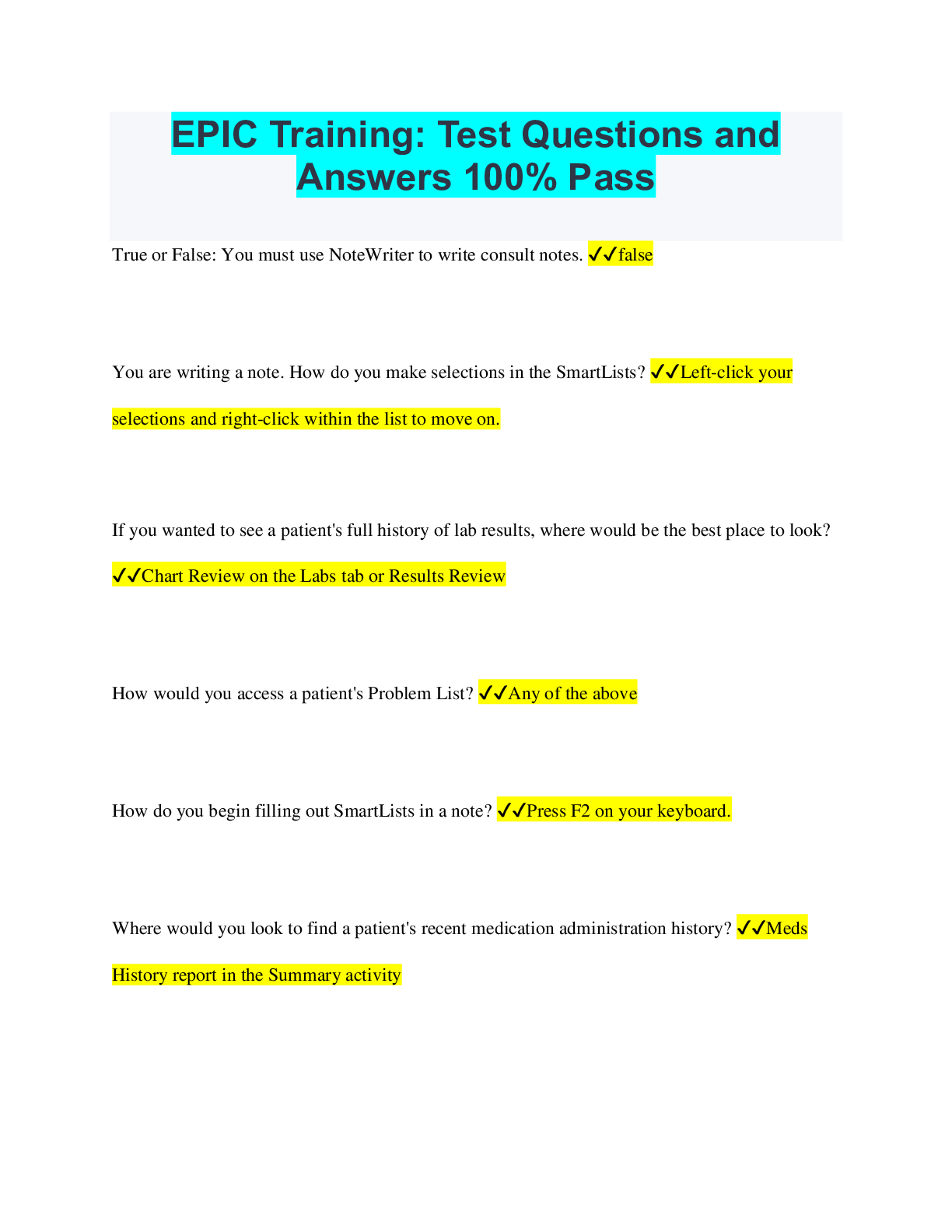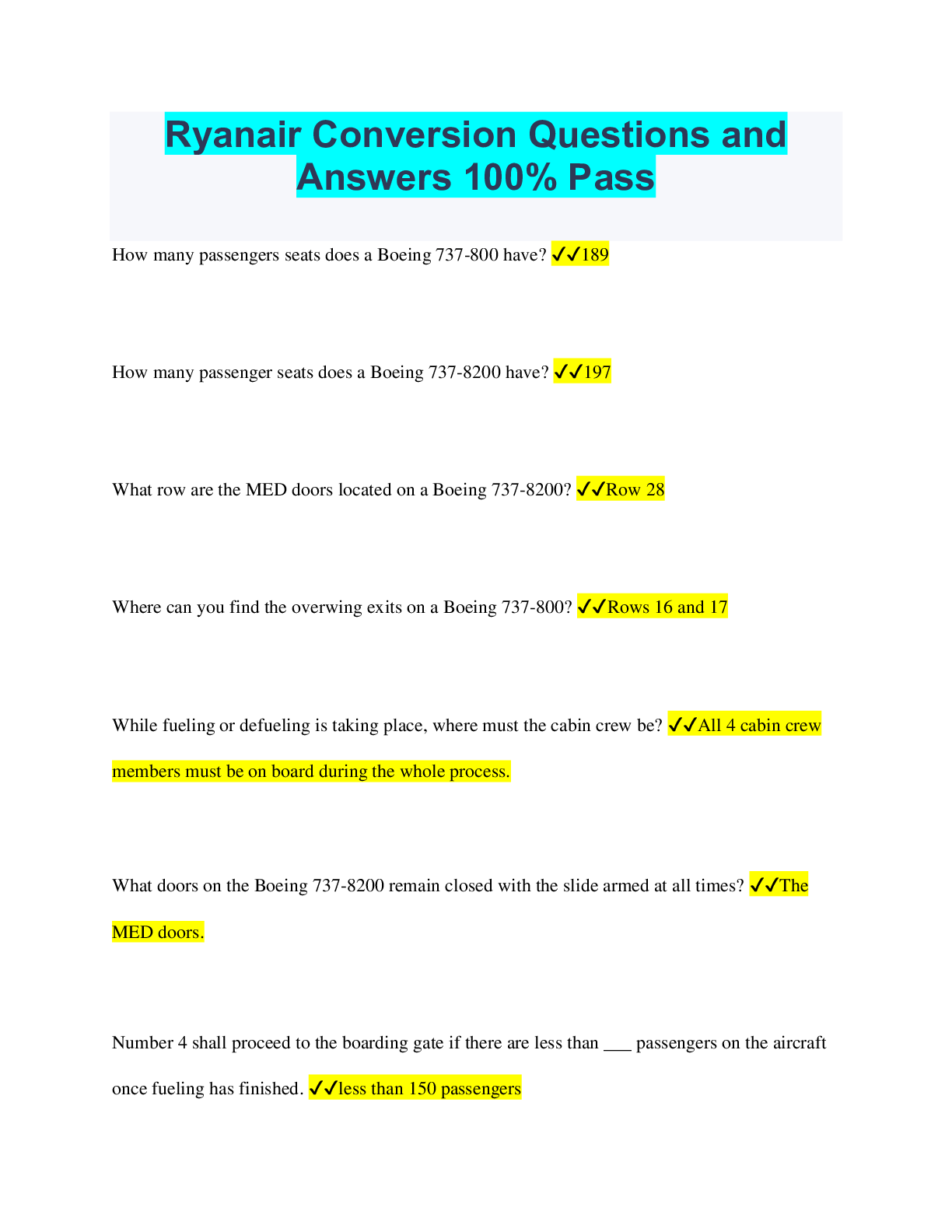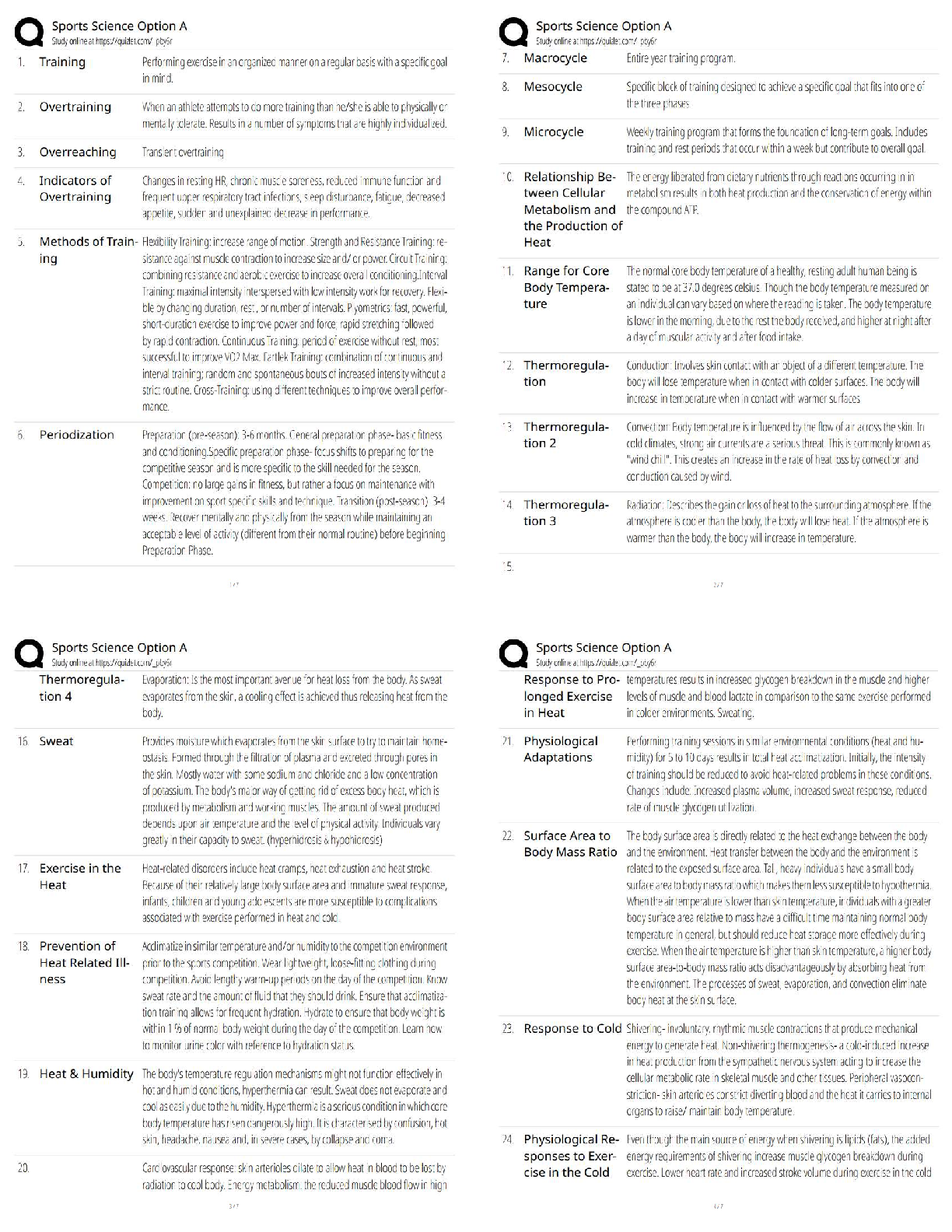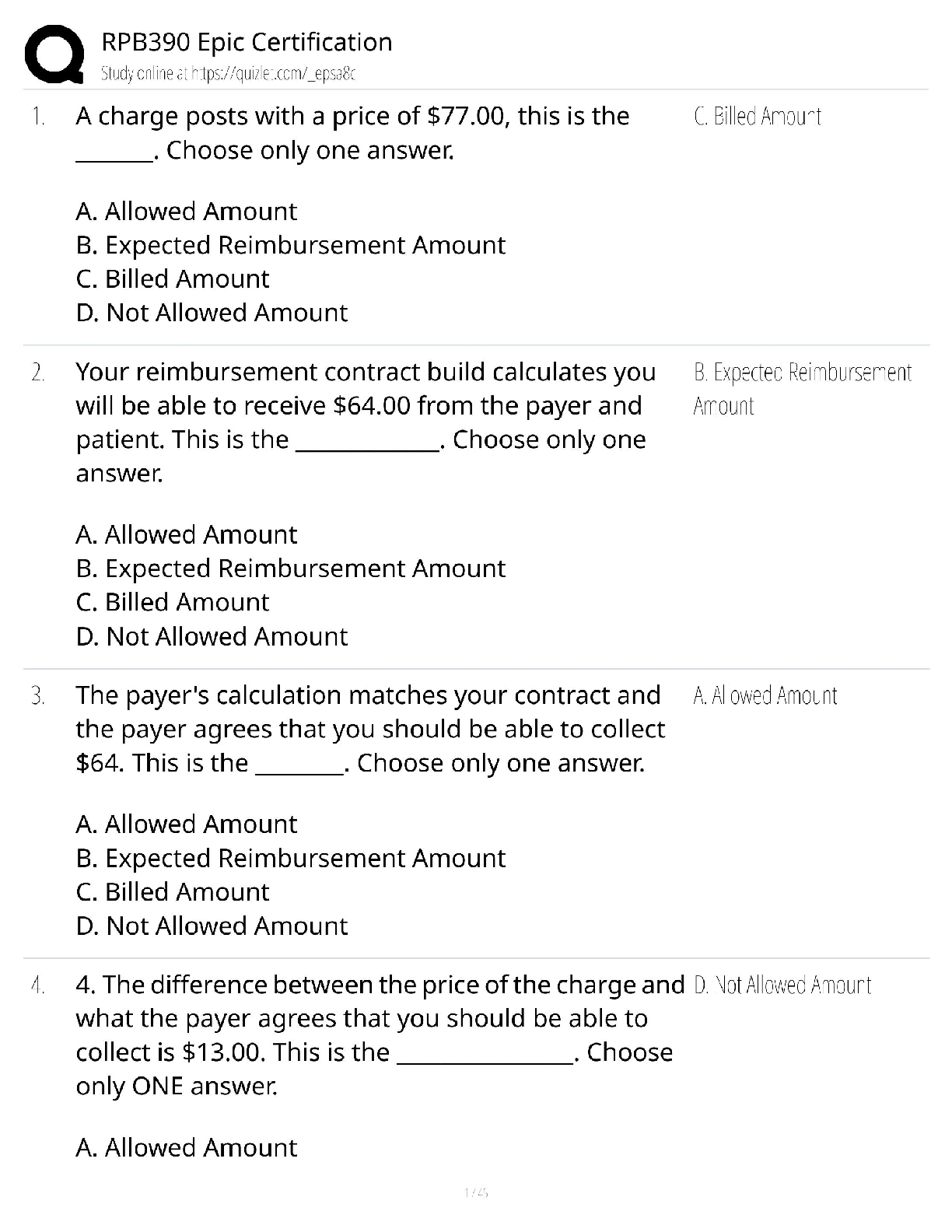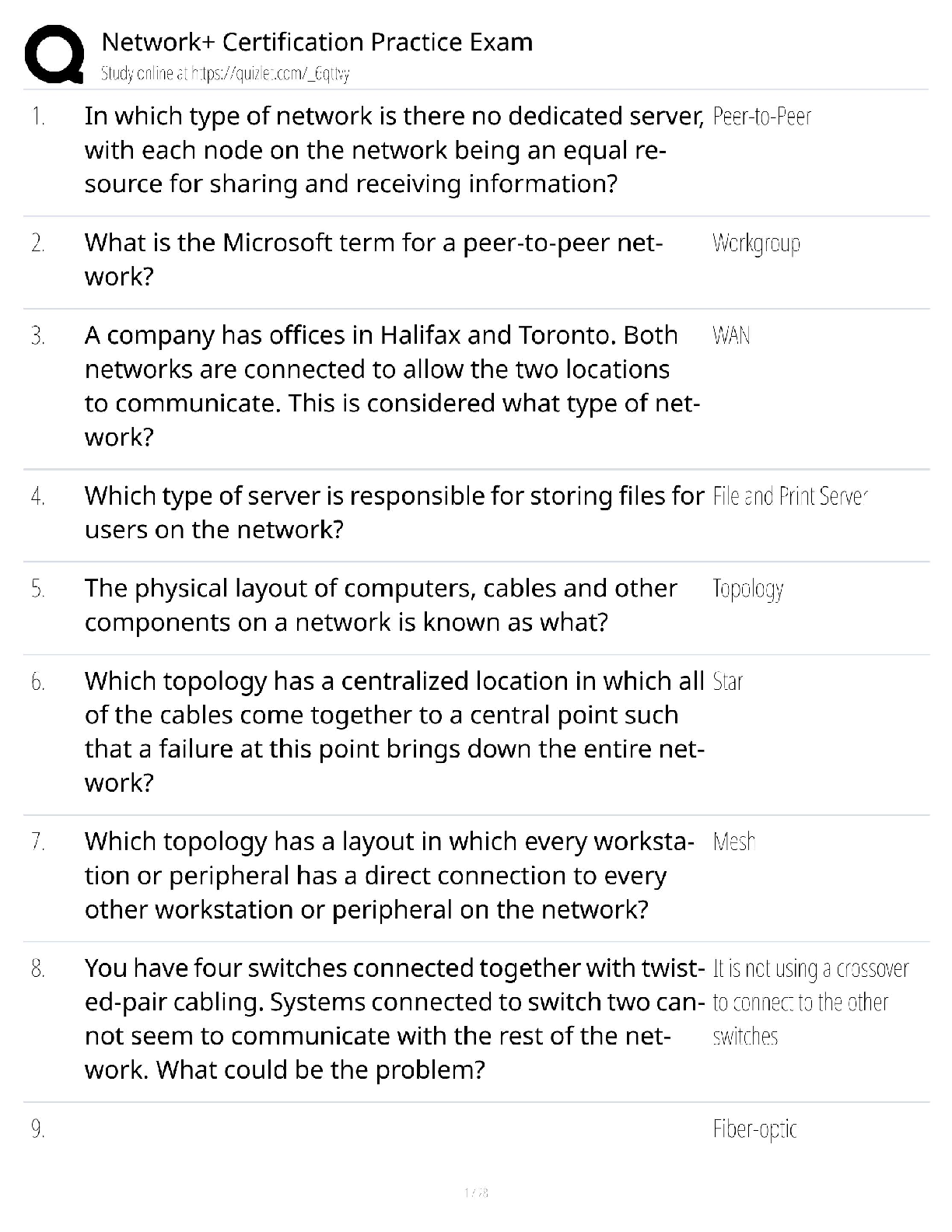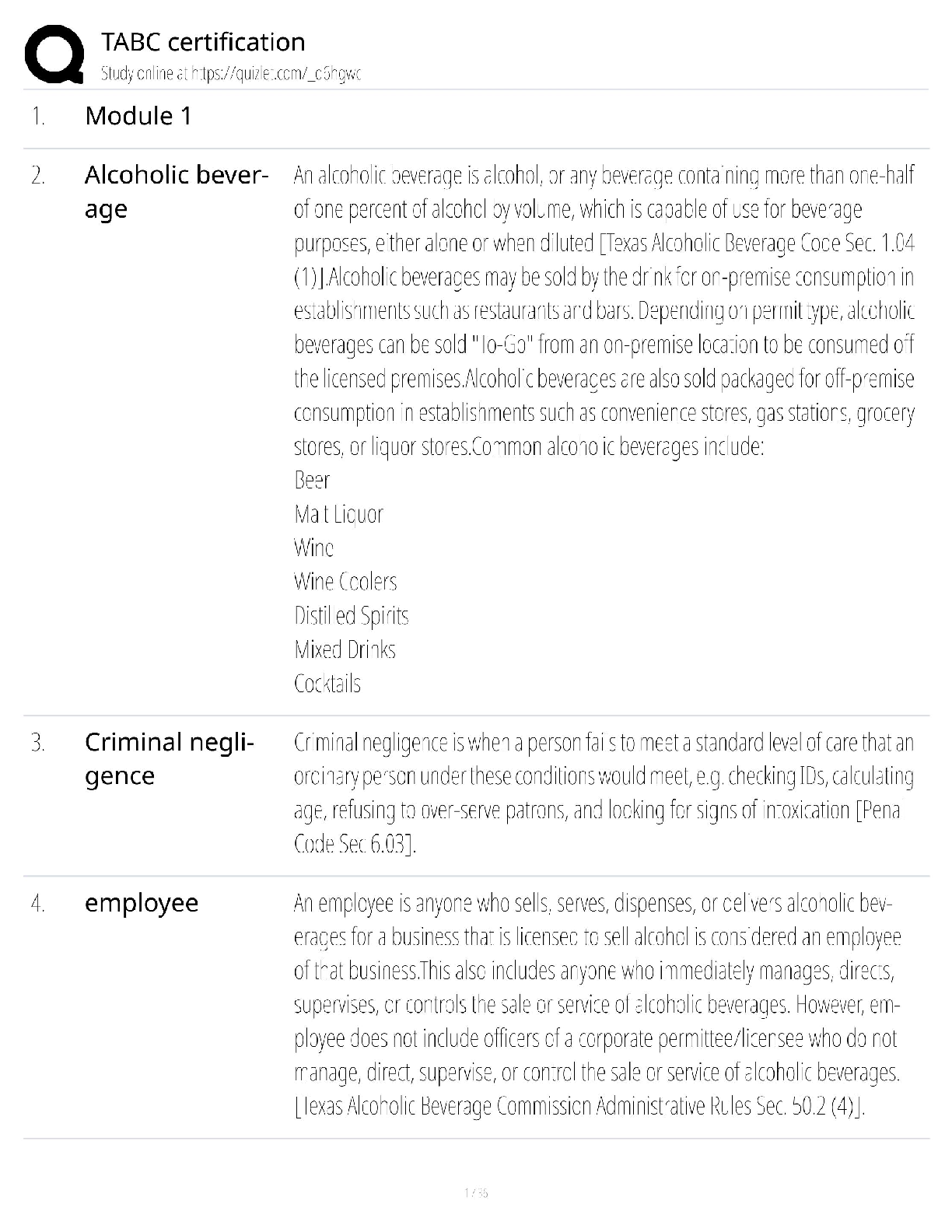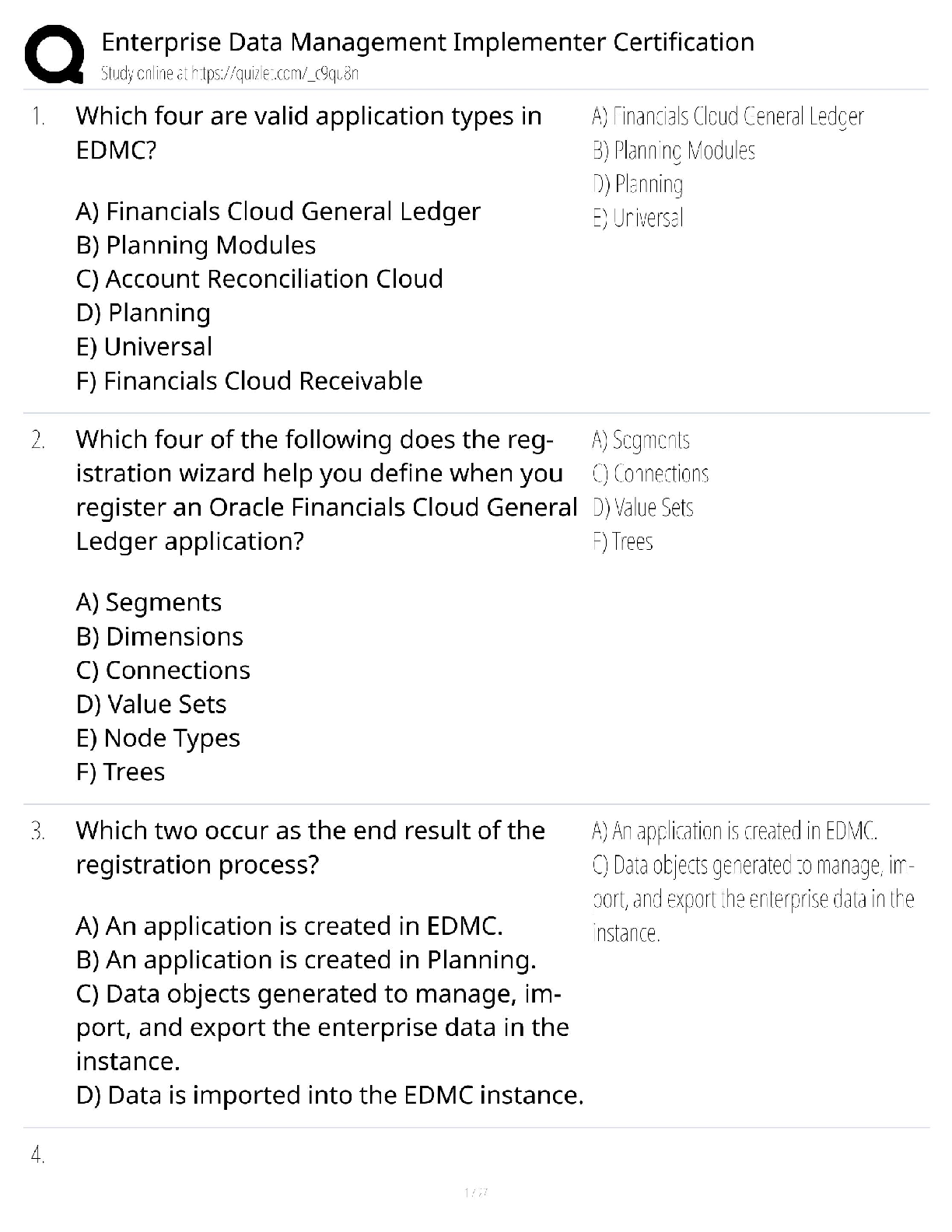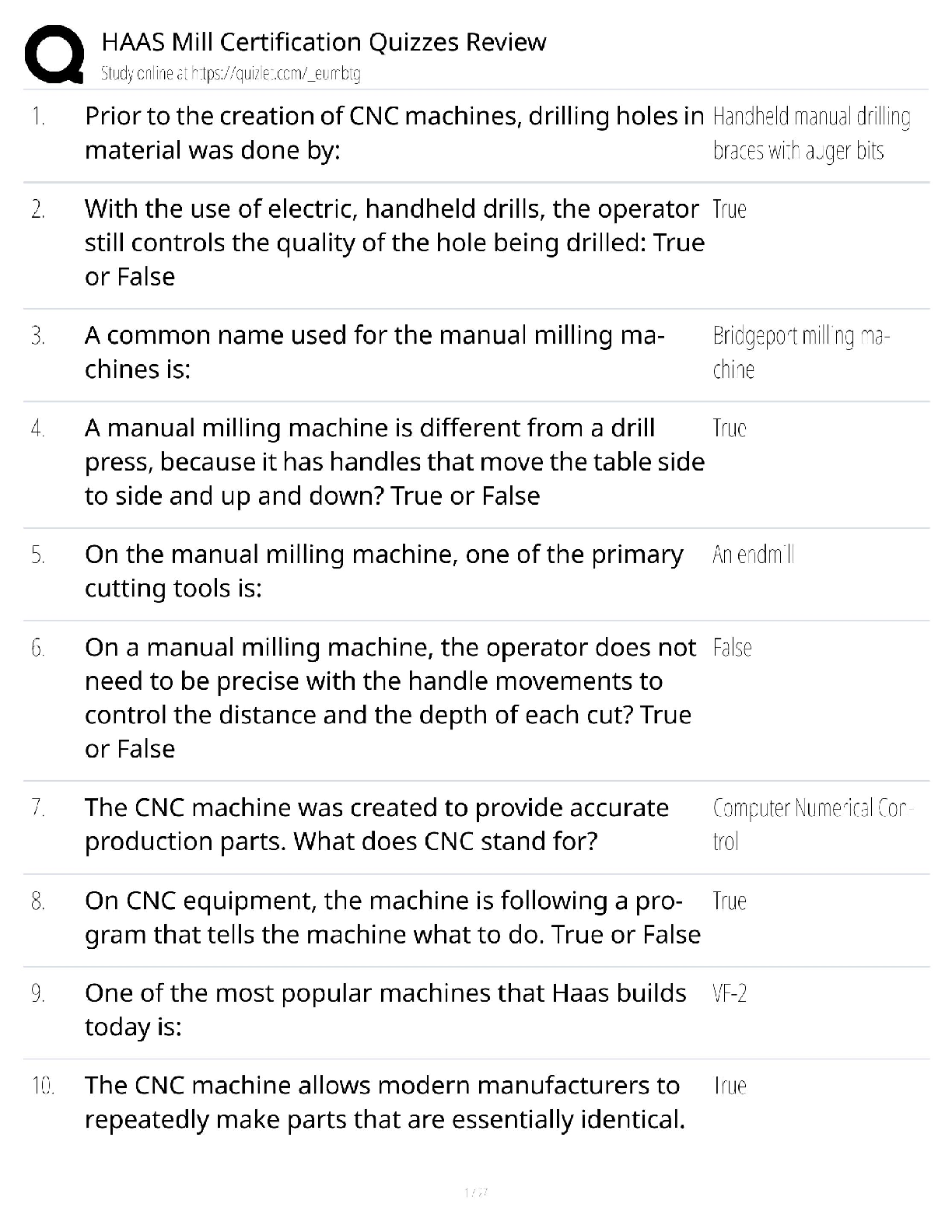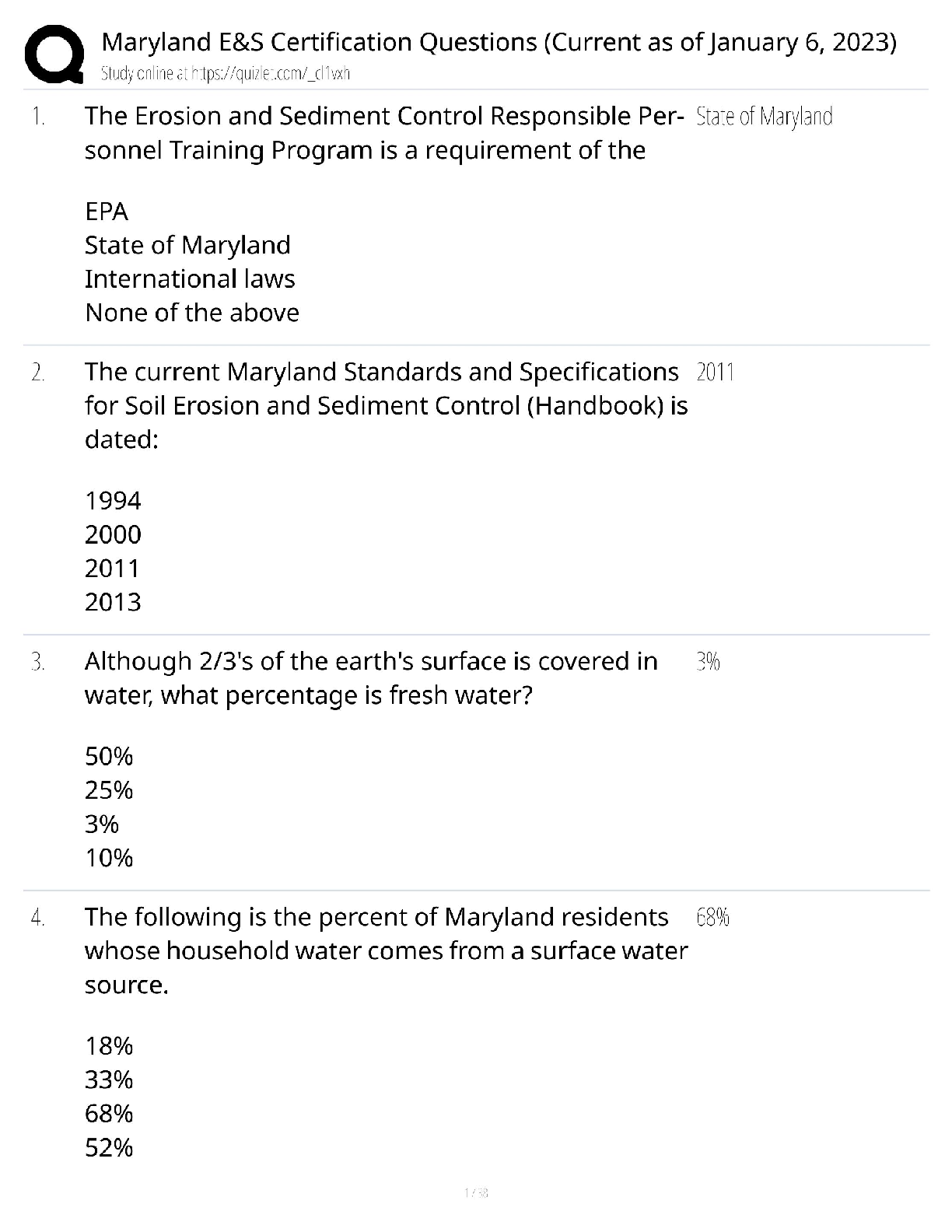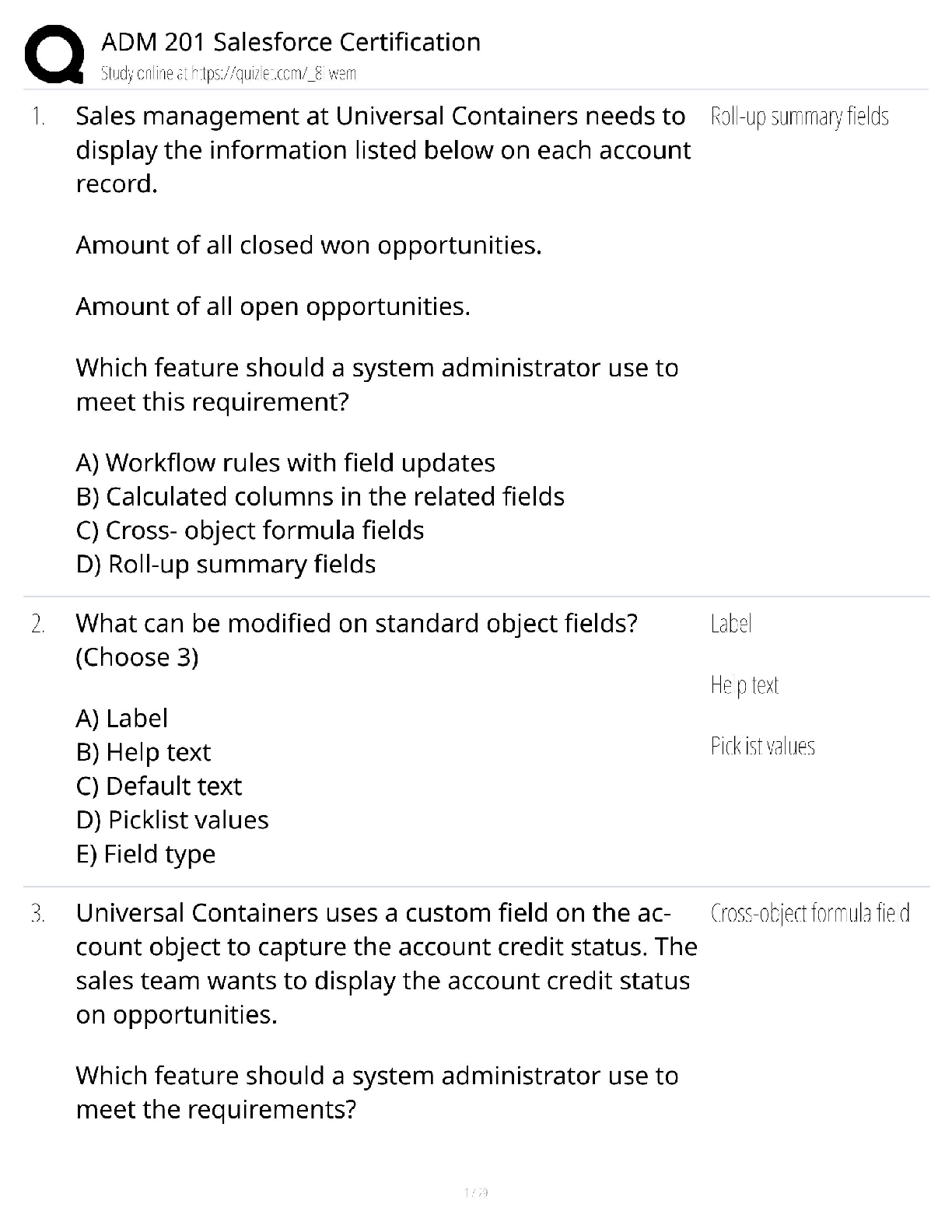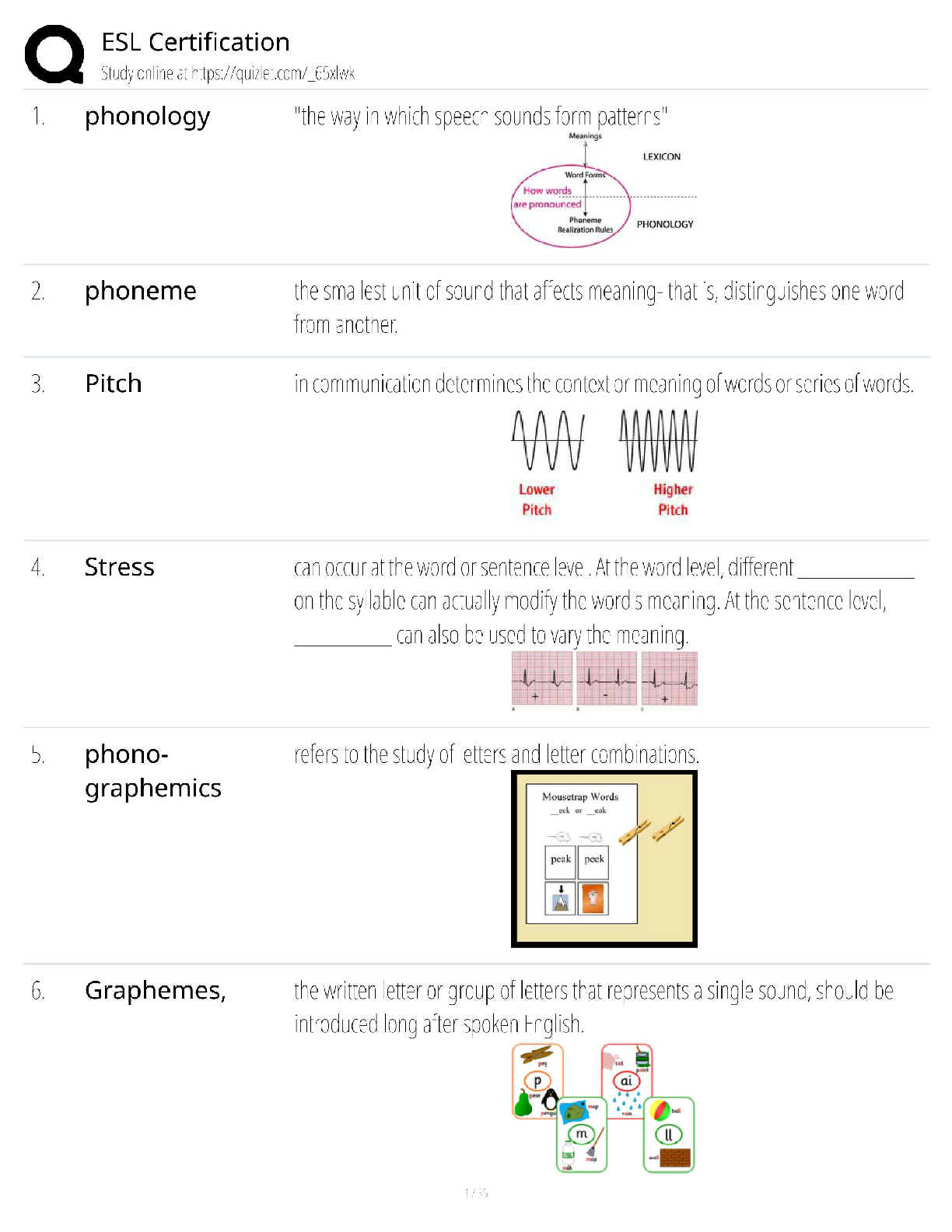Health Care > QUESTIONS & ANSWERS > AHIP – 3 Questions and Answers with Complete Solutions (All)
AHIP – 3 Questions and Answers with Complete Solutions
Document Content and Description Below
AHIP – 3 Questions and Answers with Complete Solutions Mrs. Mulcahy is concerned that she may not qualify for enrollment in a Medicare prescription drug plan because, although she is entitled to ... Part A, she is not enrolled under Medicare Part B. What should you tell her? An individual who is entitled to Part A or enrolled under Part B is eligible to enroll in a Medicare prescription drug plan. As long as Mrs. Mulcahy is entitled to Part A, she does not need to enroll under Part B before enrolling in a prescription drug plan. 3 MULTIPLE CHOICE OPTIONS Mr. Carlini has heard that Medicare prescription drug plans are only offered through private companies under a program known as Medicare Advantage (MA), not by the government. He likes Original Medicare and does not want to sign up for an MA product, but he also wants prescription drug coverage. What should you tell him? Mr. Carlini can stay with Original Medicare and also enroll in a Medicare prescription drug plan through a private company that has contracted with the government to provide only such drug coverage to eligible Medicare beneficiaries. 3 MULTIPLE CHOICE OPTIONS Mr. Jacob understands that there is a standard Medicare Part D prescription drug benefit, but when he looks at information on various plans available in his area, he sees a wide range in what they charge for deductibles, premiums, and cost sharing. How can you explain this to him? Medicare Part D drug plans may have different benefit structures, but on average, they must all be at least as good as the standard model established by the government. 3 MULTIPLE CHOICE OPTIONS Mr. Zachow has a condition for which three drugs are available. He has tried two but had an allergic reaction to them. Only the third drug works for him and it is not on his Part D plan's formulary. What could you tell him to do? Mr. Zachow has a right to request a formulary exception to obtain coverage for his Part D drug. He or his physician could obtain the standardized request form on the plan's website, fill it out, and submit it to his plan. 3 MULTIPLE CHOICE OPTIONS Mr. and Mrs. Vaughn both take a specialized multivitamin prescription each day. Mr. Vaughn takes a prescription for helping to regrow his hair. They are anxious to have their Medicare prescription drug plan cover these drug needs. What should you tell them? Medicare prescription drug plans are not permitted to cover the prescription medications the Vaughns are interested in under Part D coverage, however, plans may cover them as supplemental benefits and the Vaughn's could look into that possibility. 3 MULTIPLE CHOICE OPTIONS Mr. Wingate is a newly enrolled Medicare Part D beneficiary and one of your clients. In addition to drugs on his plan's formulary he takes several other medications. These include a prescription drug not on his plan's formulary, over-the-counter medications for colds and allergies, vitamins, and drugs from an Internet-based Canadian pharmacy to promote hair growth and reduce joint swelling. His neighbor recently told him about a concept called TrOOP and he asks you if any of his other medications could count toward TrOOP should he ever reach the Part D catastrophic limit. What should you say? None of the costs of Mr. Wingate's other medications would currently count toward TrOOP but he may wish to ask his plan for an exception to cover the prescription not on its formulary. 3 MULTIPLE CHOICE OPTIONS Mr. Shapiro gets by on a very small amount of fixed income. He has heard there may be extra help paying for Part D prescription drugs for Medicare beneficiaries with limited income. He wants to know whether he might qualify. What should you tell him? The extra help is available to beneficiaries whose income and assets do not exceed annual limits specified by the government. 3 MULTIPLE CHOICE OPTIONS Mr. Hutchinson has drug coverage through his former employer's retiree plan. He is concerned about the Part D premium penalty if he does not enroll in a Medicare prescription drug plan, but does not want to purchase extra coverage that he will not need. What should you tell him? If the drug coverage he has is not expected to pay, on average, at least as much as Medicare's standard Part D coverage expects to pay, then he will need to enroll in Medicare Part D during his initial eligibility period to avoid the late enrollment penalty. 3 MULTIPLE CHOICE OPTIONS Mrs. Quinn has just turned 65, is in excellent health and has a relatively high income. She uses no medications and sees no reason to spend money on a Medicare prescription drug plan if she does not need the coverage. She currently does not have creditable coverage. What could you tell her about the implications of such a decision? If she does not sign up for a Medicare prescription drug plan as soon as she is eligible to do so, and if she does sign up at a later date, her premium will be permanently increased by 1% of the national average premium for every month that she was not covered. 3 MULTIPLE CHOICE OPTIONS Ms. Edwards is enrolled in a Medicare Advantage plan that includes prescription drug plan (PDP) coverage. She is traveling and wishes to fill two of the prescriptions that she has lost. How would you advise her? She may fill prescriptions for covered drugs at non-network pharmacies, but likely at a higher cost than paid at an in-network pharmacy. 3 MULTIPLE CHOICE OPTIONS Mrs. Lopez is enrolled in a cost plan for her Medicare benefits. She has recently lost creditable coverage previously available through her husband's employer. She is interested in enrolling in a Medicare Part D prescription drug plan (PDP). What should you tell her? If a Part D benefit is offered through her plan she may choose to enroll in that plan or a standalone PDP. 3 MULTIPLE CHOICE OPTIONS Mr. Bickford did not quite qualify for the extra help low-income subsidy under the Medicare Part D Prescription Drug program and he is wondering if there is any other option he has for obtaining help with his considerable drug costs. What should you tell him? He could check with the manufacturers of his medications to see if they offer an assistance program to help people with limited means to obtain the medications they need. Alternatively, he could check to see whether his state has a pharmacy assistance program to help him with his expenses. 3 MULTIPLE CHOICE OPTIONS All plans must cover at least the standard Part D coverage or its actuarial equivalent. Which of the following statements best describes some of the costs a beneficiary would incur for prescription drugs under the standard coverage? Standard Part D coverage would require payment of an annual deductible, and once past the catastrophic coverage threshold, the beneficiary pays whichever is greater of either the co-pays for generic and brand name drugs or coinsurance of 5%. 3 MULTIPLE CHOICE OPTIONS Mrs. Roswell is a new Medicare beneficiary who has just retired from retail work. She is interested in selecting a Medicare Part D prescription drug plan. She takes a number of medications and is concerned that she has not been able to identify a plan that covers all of her medications. She does not want to make an abrupt change to new drugs that would be covered and asks what she should do. What should you tell her? Every Part D drug plan is required to cover a single one-month fill of her existing medications sometime during a 90-day transition period. 3 MULTIPLE CHOICE OPTIONS What types of tools can Medicare Part D prescription drug plans use that affect the way their enrollees can access medications? Part D plans do not have to cover all medications. As a result, their formularies, or lists of covered drugs, will vary from plan to plan. In addition, they can use cost containment techniques such as tiered co-payments and prior authorization. 3 MULTIPLE CHOICE OPTIONS Which of the following statements about Medicare Part D are correct? I. Part D plans must enroll any eligible beneficiary who applies regardless of health status except in limited circumstances. II. Private fee-for-service (PFFS) plans are not required to use a pharmacy network but may choose to have one. III. Beneficiaries enrolled in a MA-Medical Savings Account (MSA) plan may only obtain Part D benefits through a standalone PDP. IV. Beneficiaries enrolled in a MA-PPO may obtain Part D benefits through a standalone PDP or through their plan. I, II, and III only 3 MULTIPLE CHOICE OPTIONS One of your clients, Lauren Nichols, has heard about a Medicare concept from one of her neighbors called TrOOP. She asks you to explain it. What do you say? TrOOP stands for true out-of-pocket expenses that count toward the Medicare Part D catastrophic limit and include not only expenses paid by a beneficiary but also in some instances drug manufacturer discounts. 3 MULTIPLE CHOICE OPTIONS Mr. Shultz was still working when he first qualified for Medicare. At that time, he had employer group coverage that was creditable. During his initial Part D eligibility period, he decided not to enroll because he was satisfied with his drug coverage. It is now a year later and Mr. Shultz has lost his employer group coverage within the last two weeks. How would you advise him? Mr. Schultz should enroll in a Part D plan before he has a 63-day break in coverage in order to avoid a premium penalty. 3 MULTIPLE CHOICE OPTIONS Mrs. Allen has a rare condition for which two different brand name drugs are the only available treatment. She is concerned that since no generic prescription drug is available and these drugs are very high cost, she will not be able to find a Medicare Part D prescription drug plan that covers either one of them. What should you tell her? Medicare prescription drug plans are required to cover drugs in each therapeutic category. She should be able to enroll in a Medicare prescription drug plan that covers the medications she needs. 3 MULTIPLE CHOICE OPTIONS Mr. Torres has a small savings account. He would like to pay for his monthly Part D premiums with an automatic monthly withdrawal from his savings account until it is exhausted, and then have his premiums withheld from his Social Security check. What should you tell him? In general, he must select a single Part D premium payment mechanism that will be used throughout the year. 3 MULTIPLE CHOICE OPTIONS Which of the following individuals is most likely to be eligible to enroll in a Part D Plan? .Jose, a grandfather who was granted asylum and has worked in the United States for many years. 3 MULTIPLE CHOICE OPTIONS Mrs. McIntire is enrolled in her state's Medicaid plan and has just become eligible for Medicare as well. What can she expect will happen to her drug coverage? Unless she chooses a Medicare Part D prescription drug plan on her own, she will be automatically enrolled in one available in her area. 3 MULTIPLE CHOICE OPTIONS Which of the following statements about Medicare Part D are correct? I. Part D plans must enroll any eligible beneficiary who applies regardless of health status except in limited circumstances. II. Private fee-for-service (PFFS) plans are not required to use a pharmacy network but may choose to have one. III. Beneficiaries enrolled in a MA-Medical Savings Account (MSA) plan may only obtain Part D benefits through a standalone PDP. IV. Beneficiaries enrolled in a MA-PPO may obtain Part D benefits through a standalone PDP or through their plan. I, II, and III only 3 MULTIPLE CHOICE OPTIONS Mrs. Berkowitz wants to enroll in a Medicare Advantage plan that does not include drug coverage and also enroll in a stand-alone Medicare prescription drug plan. Under what circumstances can she do this? If the Medicare Advantage plan is a Private Fee-for-Service (PFFS) plan that does not offer drug coverage or a Medical Savings Account plan, Mrs. Berkowitz can do this. 3 MULTIPLE CHOICE OPTIONS Mr. Rice has is 68, actively working and has coverage for medical services and medications through his employer’s group health plan. He is entitled to premium free Part A and thinking of enrolling in Part B and switching to an MA-PD because he is paying a very large part of his group coverage premium and it does not provide coverage for a number of his medications. Which of the following is NOT a consideration when making the change? Mr. Rice’s retiree plan is required to take him back if, within 63 days of having voluntarily quit the employer’s plan, he decides that he prefers it to his Medicare Part D plan. 3 MULTIPLE CHOICE OPTIONS Mrs. Fields wants to know whether applying for the Part D low-income subsidy will be worth the time to fill out the paperwork. What could you tell her? The Part D low-income subsidy could substantially lower her overall costs. She can apply by contacting her state Medicaid office or calling the Social Security Administration. 3 MULTIPLE CHOICE OPTIONS Mrs. Fiore is a retired federal worker with coverage under a Federal Employee Health Benefits (FEHB) plan that includes creditable drug coverage. She is ready to turn 65 and become Medicare eligible for the first time. What issues might she consider about whether to enroll in a Medicare prescription drug plan? She could compare the coverage to see if the Medicare Part D plan offers better benefits and coverage than the FEHB plan for the specific medications she needs and whether any additional benefits are worth the Part D premium costs on top of her FEHB contribution. 3 MULTIPLE CHOICE OPTIONS Mrs. Walters is entitled to Part A and has medical coverage without drug coverage through an employer retiree plan. She is not enrolled in Part B. Since the employer plan does not cover prescription drugs, she wants to enroll in a Medicare prescription drug plan. Will she be able to? Yes. Mrs. Walters must be entitled to Part A and/or enrolled in Part B to be eligible for coverage under the Medicare prescription drug program. 3 MULTIPLE CHOICE OPTIONS Mrs. Roberts has Original Medicare and would like to enroll in a Private Fee-for-Service (PFFS) plan. All types of PFFS plans are available in her area. Which options could Mrs. Roberts consider before selecting a PFFS plan? A Medicare Advantage Prescription Drug (MA-PD) PFFS plan that combines medical benefits and Part D prescription drug coverage, a PFFS plan offering only medical benefits, or a PFFS plan in combination with a stand-alone prescription drug plan. 3 MULTIPLE CHOICE OPTIONS [Show More]
Last updated: 2 years ago
Preview 1 out of 11 pages
.png)
Buy this document to get the full access instantly
Instant Download Access after purchase
Buy NowInstant download
We Accept:

Also available in bundle (1)
Click Below to Access Bundle(s)
.png)
AHIP BUNDLED EXAMS QUESTIONS AND ANSWERS WITH VERIFIED SOLUTIONS (FULL SOLUTION PACK)
AHIP BUNDLED EXAMS QUESTIONS AND ANSWERS WITH VERIFIED SOLUTIONS (FULL SOLUTION PACK)
By Nutmegs 2 years ago
$30
23
Reviews( 0 )
$10.00
Can't find what you want? Try our AI powered Search
Document information
Connected school, study & course
About the document
Uploaded On
Feb 06, 2023
Number of pages
11
Written in
All
Additional information
This document has been written for:
Uploaded
Feb 06, 2023
Downloads
0
Views
132





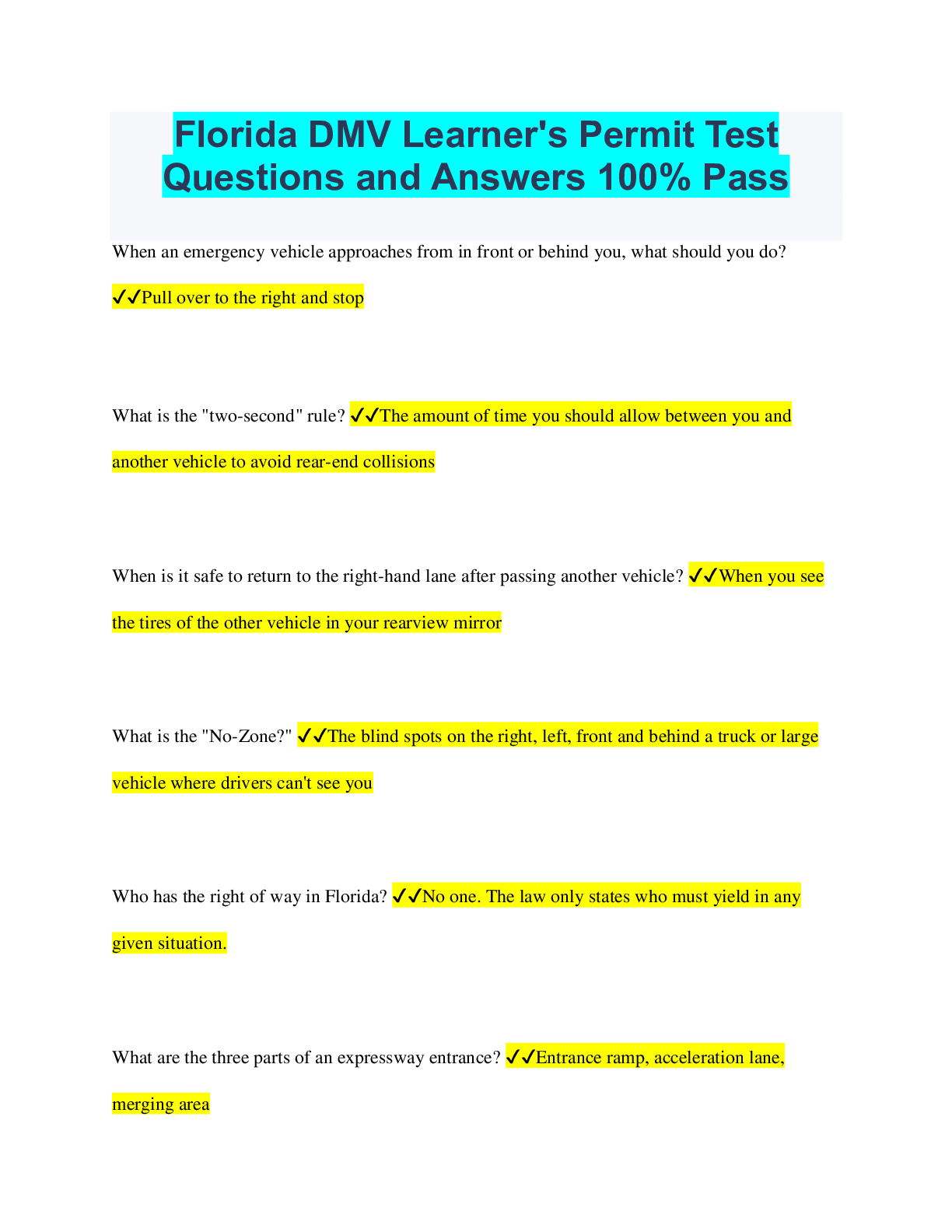
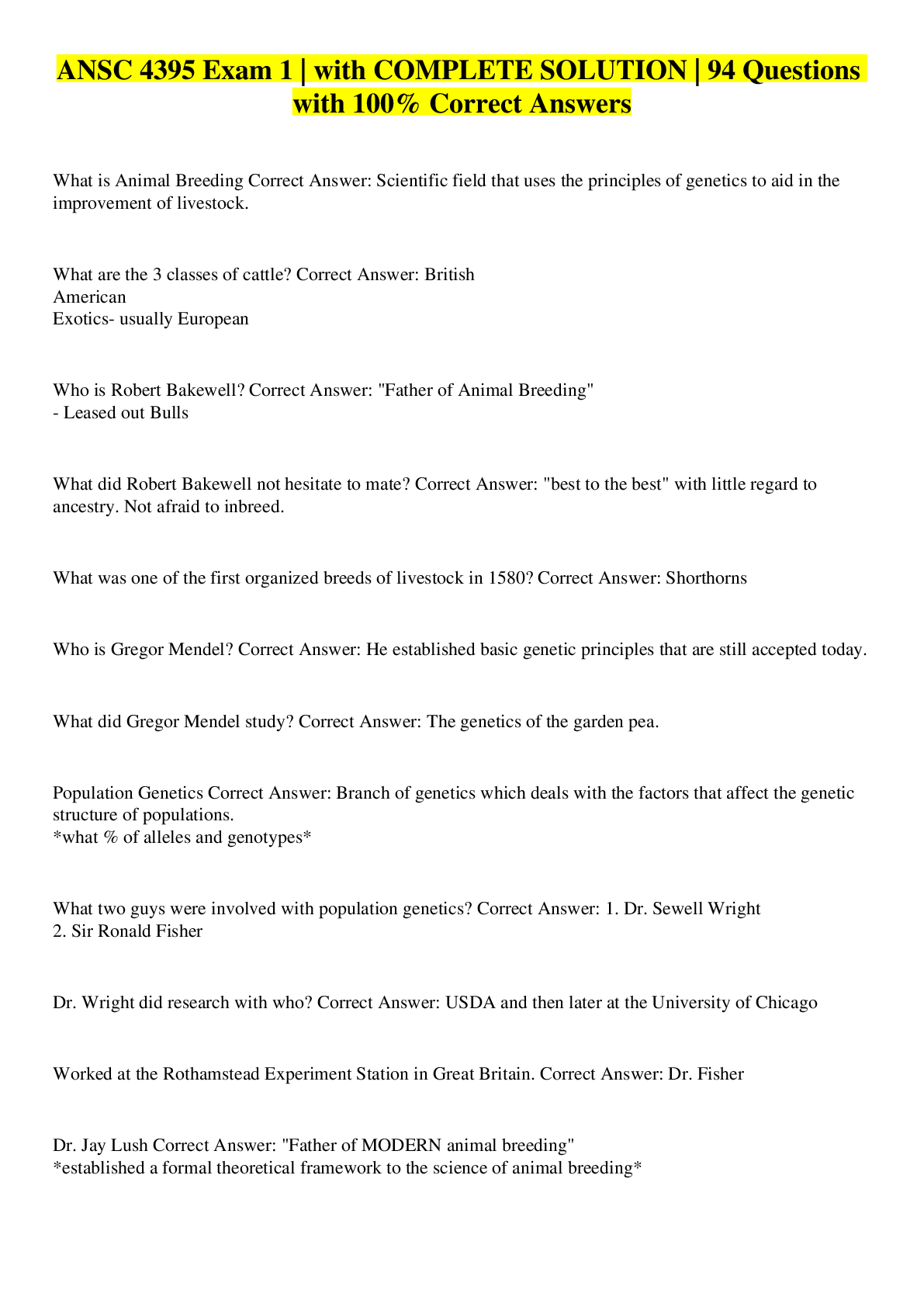

.png)


